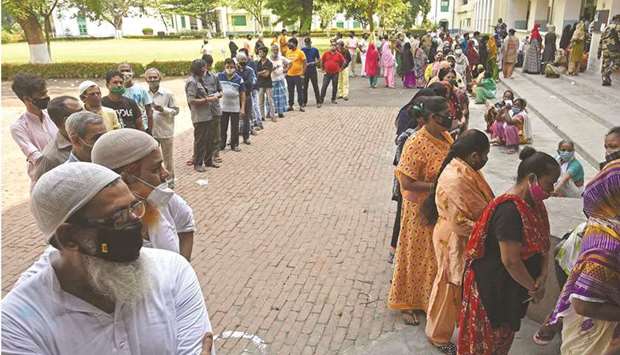India’s mammoth push to beat its raging Covid surge with vaccinations looks troubled, with its vast inoculation programme plagued by shortages, confusion and political squabbles.
From tomorrow, just as the country reels from a brutal explosion of cases, an estimated 500-600mn Indians will become eligible when the drive is opened to all adults.
Until now, only “frontline” workers like medical staff, people over 45 and those with existing illnesses have been given the AstraZeneca shot or Bharat Biotech’s homegrown Covaxin.
But even this more modest programme has faltered, with some areas running out of shots and others throwing them away because of a lack of demand, in part due to hesitancy.
“The queues here are so colossal,” said Jayanti Vasant as he waited at a busy vaccination centre in Mumbai. “The people are just fighting amongst themselves.”
So far around 150mn shots have been administered, equating to 11.5% of the population of 1.3bn people. Just 25mn have had two shots.
According to the government, Indian states have stocks of more than 10mn shots and a further 8mn will be made available in the coming days.
The Serum Institute is making 60mn-70mn AstraZeneca doses per month, and is aiming for 100mn by July.
Bharat is aiming to produce 10mn a month and targets 60mn-70mn. Indian firms also have deals to produce other shots including Russia’s Sputnik V — some of which should arrive soon — Johnson & Johnson’s single-dose vaccine and Novomax. But it could be months until these are deployed.
“Do you want to control the epidemic, save lives or both? If you want both you’ll require a huge amount of vaccines. And we don’t have it.” said T Jacob John, a retired clinical virology professor at the Christian Medical College, Vellore.
Several states have said they don’t have enough shots to start vaccinating all over-18s, including Maharashtra and New Delhi, two of the worst-hit areas.
But despite this, and even though people have to register on a government app but there may still be a rush at vaccination centres tomorrow.
On Wednesday, when online registration began, more than 13mn people signed up and users complained of technical glitches.
Further confusion has been created by New Delhi’s decision to ask states and private hospitals to order vaccine supplies on their own, creating a three-tier pricing system that requires them to pay more per dose than the central government.
This has led to squabbles between the central government, run by Prime Minister Narendra Modi’s Bharatiya Janata Party, and states governed by opposition parties.
Anecdotal evidence suggests that some private clinics have been told they won’t receive any vials for months.
Experts say that given the shortages, and its colossal population, India should have a much more targeted vaccination policy than just opening up its programme to everyone over 18.
This could include concentrating vaccinations in hotspots — some 75% of cases are in nine out of India’s 36 regions — and higher-risk population groups.
Oxygen crisis to ease by mid-May: executive
India’s severe medical oxygen supply crisis is expected to ease by mid-May, a top industry executive said, with output rising by 25% and transport infrastructure ready to cope with a surge in demand caused by a dramatic rise in coronavirus cases. Dozens of hospitals in cities such as New Delhi and Mumbai have run short of the gas this month, sending relatives of patients scrambling for oxygen cylinders, sometimes in vain. Medical oxygen consumption in India has shot up more than eight-fold from usual levels to about 7,200 tonnes per day this month, said Moloy Banerjee of Linde, the country’s biggest producer. “This is what is causing the crisis because no one was prepared for it, particularly the steep curve up,” Banerjee, who heads the company’s South Asia gas business, said yesterday. Linde – whose two affiliates in the country are Linde India and Praxair India – and other suppliers are ramping up production to a total of more than 9,000 tonnes per day by the middle of next month, he said.

Voters queue up to cast their ballot during the final phase of West Bengal’s state legislative assembly elections in Kolkata yesterday.
